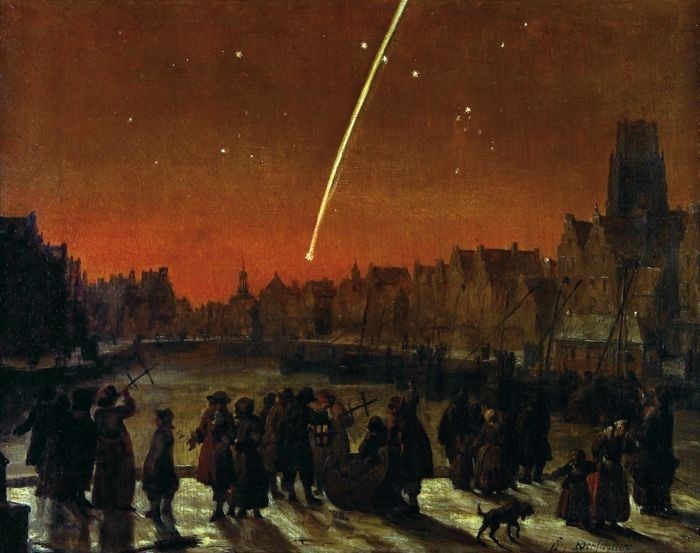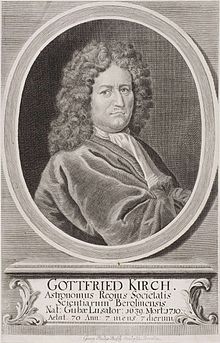Several comets have passed by Earth and have been seen by the observers nearby. However, among those comets, certain have a higher significance in our solar systems while others appear to be not so important. The Great Comet of 1680 is one such comet that has remained important in the field of astronomy for the past many decades. There are several factors about this comet which make it one of the top comets in our solar system.
Overview of The Great Comet of 1680
The Great Comet of 1680 was first seen on 14th November 1680 by a German Astronomer named Gottfried Kirch. This was the first time that a comet was seen via a telescope far away from visibility to the naked eye. The official name of this comet is Komet C/1680 V1. The Great Comet of 1680 had a perihelion point of 930,000 km or 0.0062 Astronomical Units.
It later became visible to the naked eye and was known as the brightest comet of the seventeenth century. The main reason why it has been so significant is that major research and study initiated after the appearance of this comet via a telescope. It opened up a new phase in the field of astronomy.
Although Gottfried Kirch is mostly associated with spotting The Great Comet of 1680, there have been a few others as well who observed the course path. Eusebio Kino was a Spanish Priest who devised the comet’s course. Basil Ringrose who was serving under his captain at a Port City also spotted and noted down the course of this comet.
Who was Gottfried Kirch?
Gottfried Kirch was a German Astronomer who majorly accounted for the first telescopic view of any comet in our solar system. Kirch was born on 18 December 1639 and had an interest in the field of astronomy from the beginning. He used to work as a schoolmaster initially but then proceeded ahead to calendar making which sparked his interest in comets and astronomy. By 1667, Kirch published several calendars as well as tools that would help him in astronomy and star-gazing.
By 1675, he was pursuing the opening of the Astronomical Society in Germany to further develop the field and encourage independent astronomers to observe and send their observations to a centralized location. For this purpose, Frankfurt am Main was decided as the centralized location because of easy communication. The society was aimed at coordinating astronomical events and activities to advance celestial objects.
Soon, he became the “Astronomer Royal” in Berlin and was promoted to the rank of Berlin Observatory. This happened after he observed The Great Comet of 1680. Among his works, there are various publications as well which include “Wunderstern am Hals des Walfisches. Leipzig 1678” and “Eilfertiger kurtzer Bericht an einen guten Freund von dem Neuen Cometen dieses 1682”. During the rest of his life, he searched and observed many other comets, stars, and celestial objects. Modern-day astronomy has been significantly developed due to efforts by Gottfried Kirch.
The Timeline of The Great Comet of 1680
On 14th November 1680, Gottfried Kirch was in the observatory trying to look out for different types of celestial objects. He noticed the comet first at Coburg early in the morning. At first, he was confused and felt that it could just be a nebula and not a comet. However, as the celestial object had a movement along with a tail pattern, it was confirmed that this was a comet and not any nebula. His theory of this object being a comet was not confirmed until after a week, a journal in London published the sighting of a comet just last week.
On 19th November 1680, early morning of Friday, Basil Ringrose who was sailing on the seas reported that he and his fellow members observed a comet appear from the North and had a very bright light. The tail extended up to 18 or 20 degrees as per the statement of Basil Ringrose. He added on to the fact that many prisoners also reported the incident and said that they have seen strange lights in the Capital city of Peru and other areas as well. While it may have been something else as well, the dates of this occurrence were very close to the observation of Gottfried Kirch which is why it is believed that they spotted The Great Comet of 1680.
On 30th November 1680, the comet got close to Earth. At this point, it was clearly visible from the naked eye as well. The distance of the comet from the Earth was 0.42 Astronomical Units. At this point, the comet appeared as an object with a tail of 20 to 30 degrees long. With time, the comet got so bright that it was even apparent during the daytime. This was mainly because the distance of The Great Comet of 1680 was reduced from the sun.
By 18th December 1680, the comet reached the perihelion. The perihelion point is the one where the comet is at its closest to the sun. The perihelion of The Great Comet of 1680 was only at 0.0062 Astronomical Units which is extremely close for a comet. In other terms, this was equivalent to 930,000 km or 580,000 miles only.
At this point, many people could see the comet visibly. The tail of this comet kept on increasing and was a spectacular display for many. At this point, the comet became a center of attention for numerous observatories and institutions of astronomy worldwide. As a result of this, research was advanced on The Great Comet of 1680 as well as various other celestial objects as well.
By 29th December, the comet reached the brightest light. By this time, the tail of this comet was 70 degrees. It started to appear in the evening sky as well.
From the first few days of January, the comet started the return orbit at a rapid pace. On 4th January 1681, it was again closest to the Earth with a distance of only 0.49 Astronomical Units.
Since then, The Great Comet of 1680 was on its return journey at a much more aggressive pace. It slowly started to fade away as the distance of this comet from Earth kept increasing. It was visible to the naked eye in the early days of February 1681. By March 19, the comet was observed one last time with a telescope at a distance of 2.2 Astronomical Units. One interesting fact about the final observation of this comet is that it was done by the famous scientist Isaac Newton.
Will The Great Comet of 1680 Return?
From different types of research, calculations, and observations, it is estimated that The Great Comet of 1680 is a periodic comet with an orbital period of almost 10,400 years. The answer to the question is Yes, the Great Comet of 1680 will return but only after 10,400 years of its last viewing. This means that none of us today will be able to spot or view the comet ever again. Since the comet is not returning to our solar system in a pretty long time, research and further observation on it have been paused and many astronomers are studying the different types of other celestial objects.
Conclusion
The Great Comet of 1680 was the breakthrough in the field of astronomy as well as the study of comets because it was the first comet to be observed by a telescope. With an observation arc of only 125 days, the comet gave us many valuable insights into our solar system as well as gravitational forces. However, it also left us with many questions that might never be answered.



